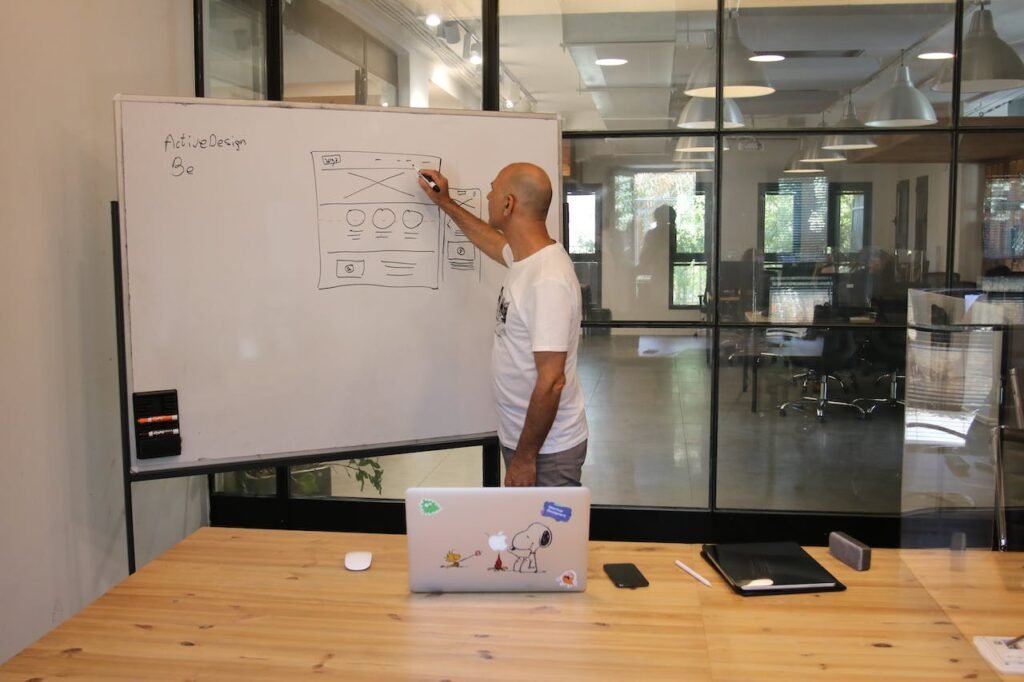
What are the career prospects for UX designers?
Exploring the Role of a UX Designer
User Experience (UX) design has evolved into a crucial component of product development, with UX designers playing a pivotal role in shaping user satisfaction and engagement. In this article, we will delve into the multifaceted world of UX design, exploring the journey, vital skills, salaries, and career prospects of UX designers.
The Journey of a UX Designer
A Dynamic and Evolving Field
The journey of a UX designer is a dynamic one. These professionals are responsible for crafting seamless and enjoyable user experiences. To embark on this path, one needs a mix of creativity, empathy, and technical skills. UX designers often start by obtaining relevant education and building a portfolio of projects that demonstrate their abilities.
Education and Skill Development
Many UX designers begin their journey with a bachelor’s degree in fields like psychology, design, or computer science. However, some enter the field through alternative routes like bootcamps or online courses. Continuous learning is essential in UX design, as technology and user preferences are constantly evolving.

Vital Skills for Aspiring UX Designers
At the heart of UX design lies a profound emphasis on the user. Aspiring UX designers must develop a user-centric mindset, which involves several key aspects:
1. Empathy:
Empathy is the cornerstone of user-centric design. UX designers must empathize with users, understanding their feelings, needs, and challenges. This enables designers to create products that resonate with users on a personal level. Empathy allows designers to step into the shoes of their audience and design solutions that genuinely address their pain points.
2. User Research:
To design products that meet user expectations, UX designers need to conduct thorough user research. This involves techniques such as surveys, interviews, and observations to gather insights into user behaviors, preferences, and pain points. By collecting and analyzing data, designers can make informed decisions that align with user needs.
3. User Personas:
Creating user personas is a common practice in UX design. These are fictional representations of target users, complete with demographics, goals, and motivations. User personas help designers empathize with specific user groups, making it easier to tailor designs to their unique requirements.
4. Usability Testing:
Usability testing involves having real users interact with prototypes or existing products to identify usability issues. This hands-on approach allows designers to witness firsthand how users navigate a product and uncover areas that require improvement.
Proficiency in UX Tools
UX designers rely heavily on various tools to execute their design processes efficiently. Proficiency in these tools is essential:
1. Wireframing and Prototyping Tools:
Tools like Sketch, Adobe XD, Figma, and Balsamiq are indispensable for creating wireframes and prototypes. Wireframes are skeletal representations of a product’s layout, while prototypes provide interactive mockups that demonstrate the user journey.
2. User Testing Software:
User testing platforms like UsabilityHub or UserTesting.com enable designers to conduct remote usability tests. These tools help in gathering feedback from real users, ensuring that design decisions align with user preferences and needs.
3. Information Architecture Tools:
Designers use information architecture tools like Axure RP or OmniGraffle to organize the structure and hierarchy of information within a product. This is crucial for ensuring that users can easily navigate and find what they need.

Collaboration and Communication
Effective collaboration and communication are essential for UX designers to work harmoniously within cross-functional teams:
1. Team Collaboration:
UX designers frequently collaborate with developers, product managers, graphic designers, and other team members. They should be open to feedback, willing to compromise, and able to integrate various perspectives into their design decisions.
2. Design Thinking Workshops:
Participating in design thinking workshops can enhance collaboration. These workshops bring team members together to brainstorm ideas, identify problems, and collectively explore potential solutions.
3. Communication Skills:
UX designers must articulate their design rationale clearly and persuasively. They should be skilled at presenting their ideas to both technical and non-technical stakeholders, using visual aids, prototypes, and user research data to support their arguments.
4. Empathetic Communication:
Empathetic communication extends beyond users to team members. Understanding their colleagues’ perspectives and being considerate of their input fosters a collaborative and productive work environment.
Unveiling the Landscape of UX Designer Salaries
Hourly Earnings in the World of UX Design
The compensation for UX designers is subject to various influencing factors. These include the location of employment, the designer’s experience level, and the size and reputation of the employing company. On average, UX designers can expect to earn an hourly rate ranging from $30 to $60. However, it’s important to note that experienced professionals in high-demand regions can command significantly higher wages, sometimes exceeding $100 per hour.
Navigating UX Designer Salaries Based on Experience
As UX designers progress in their careers, their salaries typically undergo a noticeable transformation:
Entry-Level Designers:
At the outset of their careers, entry-level UX designers typically start with a modest salary. This introductory compensation reflects their limited professional experience.
Mid-Level Designers:
With a few years of experience under their belts, mid-level UX designers can anticipate substantial salary increases. Their growing expertise and proficiency in the field make them more valuable assets to their employers.
Senior UX Designers:
Senior UX designers, often considered the experts in their field, often command six-figure incomes. Their comprehensive knowledge, leadership skills, and ability to strategize and execute complex projects set them apart.
Top 5 Cities for UX Designer Careers
Where the Community of UX Designers Thrives
The demand for UX designers is not uniform across all geographic regions. Certain cities have established themselves as hotspots for UX design careers. These include:
1. San Francisco:
Known as the tech capital of the world, San Francisco offers numerous job opportunities for UX designers. The city’s innovative atmosphere and concentration of tech companies make it an ideal place to thrive in this field.
2. New York:
As a major hub for businesses across diverse industries, New York City provides a vibrant ecosystem for UX designers. The city’s diverse clientele and bustling creative scene contribute to the high demand for UX professionals.
3. Seattle:
Home to tech giants like Amazon and Microsoft, Seattle boasts a robust UX design community. The presence of these industry leaders ensures steady career prospects and competitive salaries for UX designers.
4. Boston:
Boston’s academic and tech sectors create a conducive environment for UX designers to excel. The city’s rich history of innovation and research aligns well with the UX field’s emphasis on user-centric design.
5. Austin:
Austin, Texas, has emerged as a tech hub in recent years. With a lower cost of living compared to some other tech cities, it attracts both established and aspiring UX designers looking to make an impact in a thriving tech scene.

Assessing the Current Demand for UX Designers
A Glimpse into the Future of UX Design Careers
The demand for UX designers remains on an upward trajectory. As technology continues to permeate every facet of our lives, the need for professionals who can craft exceptional user experiences becomes increasingly critical. The evolution of technology, including emerging fields like augmented reality (AR) and virtual reality (VR), further expands the scope of UX design.
Company Sizes Hiring UX Designers
Average Team Sizes in the UX Design Field
Companies of varying sizes recognize the significance of UX design in achieving business success. Smaller startups and businesses may maintain smaller, agile design teams, allowing for more direct involvement in projects. In contrast, tech giants and established corporations may employ extensive teams of UX designers to ensure that their products meet and exceed user expectations. The size of the design team often corresponds to the scale and complexity of the company’s product offerings.
The Educational Path to Becoming a UX Designer
Must-Have Design System Tools for UX Designers
To excel in the field of UX design, aspiring designers should equip themselves with knowledge of design systems and the essential tools used to create and manage them. Tools such as InVision Design System Manager (DSM) or Abstract play a pivotal role in streamlining design processes. Design systems help maintain consistency and efficiency throughout the design process, facilitating collaboration and ensuring that the user experience remains cohesive.
Climbing the Ladder: Senior Roles for Experienced UX Designers
Senior UX Designer Roles
As UX designers accumulate experience and expertise, they gain access to senior-level roles that come with increased responsibilities and higher salaries. These roles include:
UX Lead:
UX leads are responsible for overseeing and guiding the design team, ensuring that projects align with the company’s vision and user needs.
Design Manager:
Design managers take on broader leadership roles, managing multiple design teams and projects within an organization.
Director of User Experience:
At the highest echelons of UX design, directors of user experience shape the strategic direction of an organization’s user experience efforts, influencing product development, and user engagement on a large scale.
Advancements in UX Design
Incorporating New Technologies
With the advent of augmented reality (AR), virtual reality (VR), and voice interfaces, UX designers will have the chance to explore innovative ways of enhancing user experiences.
Evolving Roles
The role of a UX designer is not static. As the field evolves, professionals may find themselves taking on hybrid roles that involve elements of interaction design, usability research, and information architecture.
Conclusion
In conclusion, the journey of a UX designer is both rewarding and ever-evolving. With the right education, skills, and a user-centric mindset, anyone can embark on a successful career in UX design. The demand for UX designers continues to grow, promising exciting opportunities in a variety of industries.

Muhammad Moiz, a Dartmouth College Computer Science major, is an experienced and respected figure in the fields of digital marketing and programming. Moiz excels in demystifying complex technical topics, making him a valuable resource for both seasoned professionals and those new to the tech world.

